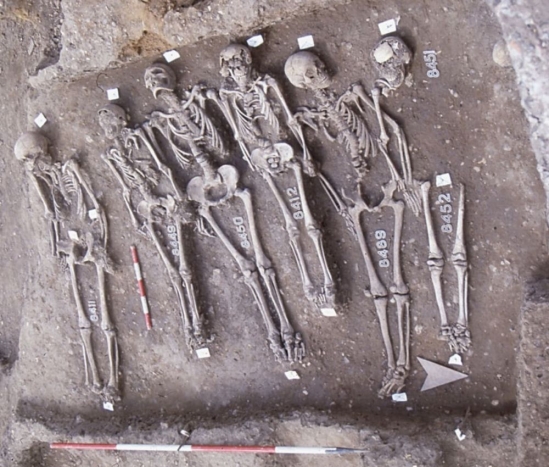Archaeologists Examine the Enduring Human Costs of Epidemics
And What We Might Learn from Covid

Epidemics and pandemics are not equal-opportunity killers. Seen through the archaeological record, incomplete as it may be, these waves of death victimized the marginalized and most vulnerable populations wherever they struck.
In the U.S., the COVID-19 pandemic appears to be no different, striking Indigenous, Black and Latinx communities at far greater rates than white populations.
“What’s going on today is nothing new,” said Lynn Gamble, a UC Santa Barbara professor emerita of anthropology and editor of the journal American Antiquity.
Indeed, in a peer-reviewed paper published by the journal, Gamble and the editorial board examine the human costs — social, cultural, economic — of epidemics in ancient societies and consider “how the study of disasters, such as pandemics, can contribute to the growth of an archaeology that both furthers our understanding of the major challenges that humanity faces and supports the creation of equitable and scientifically supported agendas and solutions.”
In “Finding Archaeological Relevance during a Pandemic and What Comes After,” the journal takes a step away from its usual archaeology scholarship to put epidemics in social-historical context. The pandemic demanded it, said Douglas J. Kennett, a UCSB professor of anthropology and member of the journal’s editorial board.
“Yes, this is a departure for American Antiquity, but it is part of an overall trend in archaeology that is starting to address broad questions of contemporary relevance,” he said. “Archaeology is the only discipline that provides the long-term datasets necessary to put contemporary issues like the societal impacts of infectious disease into broader context. We know from past epidemics that rapidly spreading infectious disease impacts economic wellbeing. We see this repeatedly in the pre-contact period, historically and today with the spread of COVID-19.”
One of the most pervasive effects of epidemics, the authors assert, is inequality, which is “strongly associated with colonial situations.” Indeed, the groups most affected by the pandemic today are descendants of Indigenous and Black communities.
The paper notes that these groups suffer not just from the disease itself, but from social structures imposed by colonial forces. Among the Indigenous people of North America in particular, the trappings of colonialism were a major contributor to their devastation.
“Many scholars previously overemphasized the effects of introduced diseases from Europeans in the Americas without considering the contexts that contributed to their spread.” Gamble said. “The simple version was people didn’t have immunity and they died. But archaeologists were not always looking at the social issues that set that situation up. If you’re placed in mission barracks with very little air circulation and limitations on leaving that environment, it’s setting that population up for disease.”
For Black communities, lack of access to health care, fresh foods, safe housing and neighborhoods, and educational and employment opportunities continue to plague its members, the paper reports.
“This constellation of issues stems from the other multigenerational pandemic it represents: long-standing and virulent and anti-Black racism and the extensive systemic and practical effects of white privilege and supremacy,” the authors write. “Our duty as archaeologists is to make sure that those histories are not forgotten. They are precursors to the present, and these narratives and structural realities remind us that these conditions are not new nor are they ‘over.’ ”
As Gamble noted: “I think there’s no question that Black lives have been hit by the current pandemic, much worse. And this is what we see in history.”
Paleopathology — the study of ancient diseases — can also provide insights into the scourges of humanity. The paper examines the development of biomedical techniques used “to test hypotheses about the long-term evolution of human disease and human-pathogen interactions.”
Two approaches, the detection of pathogens in ancient DNA (paleogenomics) and the study of ancient proteins (paleoproteomics) are emerging as important research tools. Each is promising in its ability to identify pathogens — often found in dental calculus.
“Paleogenomics and paleoproteomics are both game changers for the study of infectious disease in the past and the impact of pandemics on ancient societies,” Kennett said.
Gamble notes that “with these tools, archaeologists are able to document the origins of disease as well as provide deep context for their geographic spread over millenia.”
The paper also addresses the impacts of climate change, how epidemics and pandemics affect material culture, insights into ancient diseases and more. Kennett, who wrote a section on “Ecology of Infectious Disease, Agriculture, and Demographic Transitions,” said the archaeological record demonstrates the complex social, economic and political contexts that result in selective mortality of vulnerable and marginalized groups.
“What is clear from the long-term record is that epidemics are selective and have a greater impact on marginalized groups already suffering from malnutrition and other ailments,” he said. “We see this with the Black Death in Europe during the 14th century where the disease (in this case bubonic plague) selectively killed the elderly and people with preexisting health conditions. This was made worse by a climatic downturn in Europe during this time. Work on past epidemics helps highlight that multiple factors affect the spread of infectious disease and that the impact is selective. It is now up to governments to create the necessary safety nets to ensure that vulnerable populations are protected.”
Gamble, one of the most prominent scholars of California’s Indigenous peoples, said the paper’s clear-eyed look at the legacy of epidemics is overdue.
“We use some fairly strong words in there,” she said. “Perhaps by highlighting this, that this is nothing new, we can attempt to make more serious changes in our governments and economic, social changes that will improve the situation so that we don’t continue to see this happen.”
This article is reprinted with permission from UC Santa Barbara’s Office of Public Affairs and Communications.



